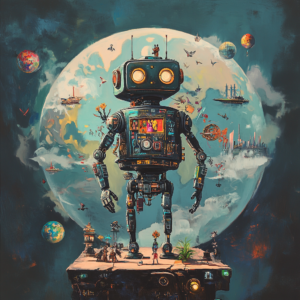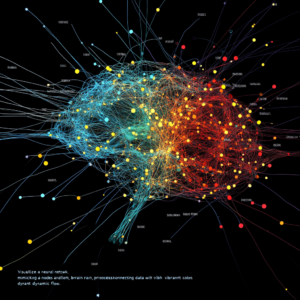
“Bridging the Brand-Consumer Gap: The Impact of Generative AI on Customer Experience”
In the bustling agora of modern commerce, where the brands drum loudly for attention and consumers scroll endlessly, a revolutionary force is afoot: generative AI. This isn’t just your run-of-the-mill tech fad; it’s akin to opening a portal to a whole new realm of brand-consumer relationships. So, let's strap on our metaphorical boots and dig deep into how generative AI is deftly weaving the tapestry that connects brands with their customers, and what this means for the exhilarating future of customer experiences.
Generative AI, in essence, is like a Swiss Army knife, not merely there to slice off the mundane tasks but to sculpt intelligent, engaging experiences that resonate with consumers. It’s not just about making recommendations but hyper-personalizing every minute interaction. Imagine a tech wizard foreshadowing your desires before you even express them—this isn’t the stuff of dreams anymore, it’s happening now.
Hyper-Personalized Recommendations
Let’s take a music streaming giant like Spotify, which is no stranger to the magic of generative AI. By blending algorithmic prowess with a sprinkle of human touch, Spotify gifts us with personalized playlists that feel crafted just for us. Remember those days when the “Discover Weekly” playlist felt like your soundtrack just dropped out of the cosmos? That’s the beauty of AI playing the role of both DJ and curator. This kind of personalization doesn’t just elevate customer satisfaction; it boosts Net Promoter Scores (NPS) faster than a caffeine fix on a Monday morning.
Anticipating Customer Needs
Generative AI doesn’t just react; it anticipates. Like a forward-thinking partner who knows your cravings before you do, this tech marvel can sift through mountains of data, identifying patterns to see into the future of consumer desires. This anticipatory nature ensures that brands are not just keeping pace but often leading the marathon—their insight finely tuned to what the customer might need next.
Bridging the Linguistic Chasm
In this global marketplace, communication is key. Generative AI steps in as the polyglot who masters not just language but context, delivering accurate responses in the native tongues of consumers. Did you know that a whopping 68% of customers prefer to interact in their comfortable linguistic setting? That’s a fact worth noting—brands that adapt to this preference are riding high on the trust wave.
Elevating Retail Experiences
Now let’s meander over to the retail landscape, where generative AI is sprucing up the old-school shopping experience in myriad captivating ways:
Personalized Shopping
Picture this scenario: You walk into a store, and immediately, your favorite products seem to float toward you. Generative AI identifies your shopping patterns, crafting recommendations that resonate with your taste buds, thus boosting engagement and conversion rates like a shot of espresso on a sleepy afternoon. Plus, the modern consumer craves customization—whether it’s a unique pair of sneakers or dapper suits. Picture yourself designing your own products, powered by AI’s stunning imaging capabilities—now that's shopping jazz!
Operational Efficiency
In the labyrinth of retail operations, AI can be the guiding light. It gives brands the tools to automate processes, enhancing not just customer satisfaction but internal efficiency. Imagine an AI overseeing every customer interaction—polishing those touchpoints to ensure nothing but a gleaming brand image.
Innovative Physical Store Experiences
Even the hallowed halls of brick-and-mortar stores are witnessing the AI renaissance. Generative AI can suggest layouts, optimal product placements, and even help customers navigate through retail mazes like a savvy friend showing you the best shortcuts in a sprawling city. It’s all about making that shopping journey personalized, intuitive, and enjoyable.
Confronting Consumer Skepticism
However, amidst this wondrous carnival of innovation lies a weighty challenge: consumer skepticism. There’s often a chasm between how advertisers perceive AI-generated ads versus how the average consumer reacts. This disconnect can spell trouble if not addressed.
Disclosure and Transparency
Let’s face it; young consumers, particularly from the Gen Z cohort, aren’t easily fooled. They remain skeptical of AI-generated ads. Brands need to be upfront about it—transparency is the golden rule. It’s crucial to explain how AI contributes to these ads. Build trust or face the wrath of a wary audience!
Preferred Media Channels
Gen Z and Millennials like to see their AI-generated ads strutting their stuff on social media and online platforms—no surprise there! Brands that align their strategies with these preferences are setting the stage for success.
Creative Best Practices
Now, just because AI is behind the curtain doesn’t mean the show should lack flair. AI-generated ads should adhere to the same engaging and creative guidelines as their human-made counterparts. Relevance is key; if the ad doesn’t align with the brand's vibe, it’ll hit the proverbial brick wall.
The Growing Threat of Fraud and Security
As generative AI sashays into the spotlight, it also opens up new avenues for tricksters. Better brace yourself—it’s a double-edged sword.
Exploiting Vulnerabilities
Fraudsters are ever-evolving, using generative AI to exploit customer touchpoints like online transactions or call centers. Brands must be armed with robust defenses in their digital arsenal to counter these threats and protect consumer data.
Finding Balance in AI Adoption
The successful melding of generative AI into brand strategies isn’t just about jumping on the tech train; it’s about striking a harmonious balance that considers the benefits versus the challenges.
Understanding the Impact of AI
Brands must close the knowledge gap in AI adoption. Research suggests there’s significant value hidden beneath the surface—think about an astounding 14% productivity boost coupled with higher NPS scores!
Education and Transparency
On top of that, today’s consumers are savvy—they expect AI to offer more than just cost reductions. Brands need to educate their customers on how AI boosts their experiences, ensuring transparency at every turn.
Wrapping It All Up
Generative AI stands on the brink of a remarkable transformation, sculpting a world where brands and consumers forge deeper connections through personalized, engaging experiences. But let's be honest—implementation isn’t a walk in the park. It requires a delicate touch with a keen eye on consumer perceptions, transparency, and security.
As we catapult into this bright future, it’s crucial for brands to:
- Leverage AI Responsibly: Tune into customer expectations and align AI solutions accordingly.
- Educate Consumers: Build trust by disclosing how AI enhances their experience.
- Enhance Security: Fortify defenses against fraudsters who seek to exploit AI-generated environments.
By beautifully harmonizing the precision of AI with the inherent intuition and empathy of the human experience, brands can cultivate a loyal and satisfied customer base that keeps coming back for more.
Want to stay up to date with the latest news on neural networks and automation? Subscribe to our Telegram channel: @ethicadvizor

